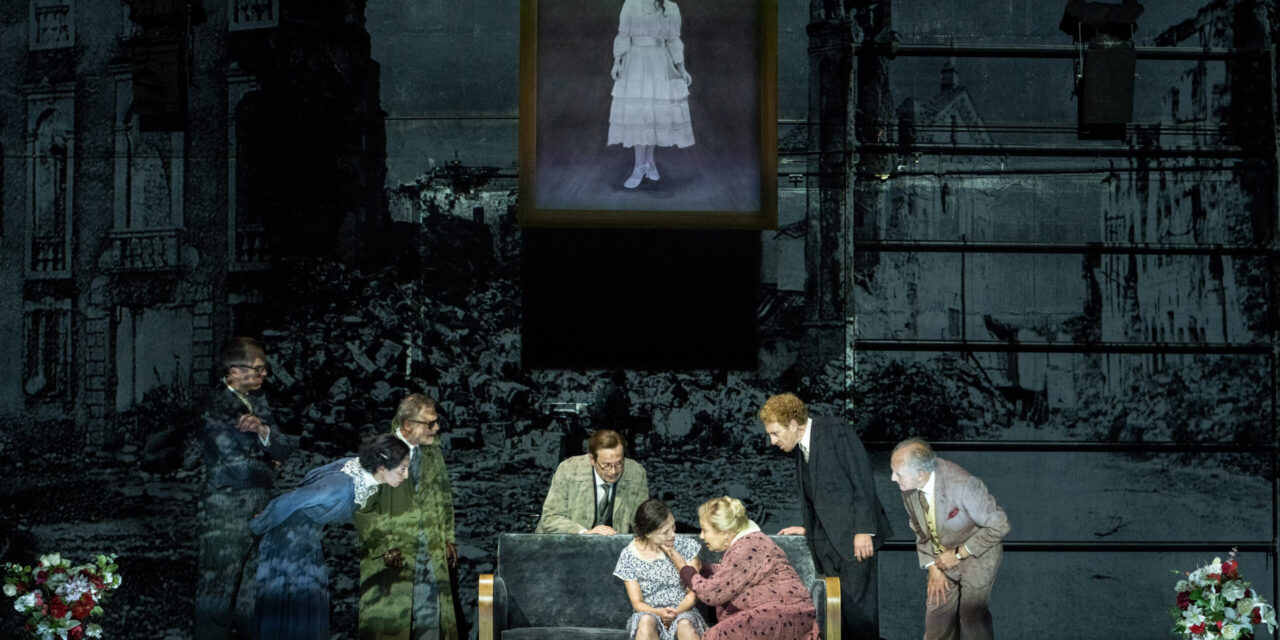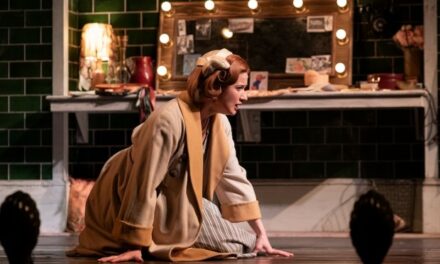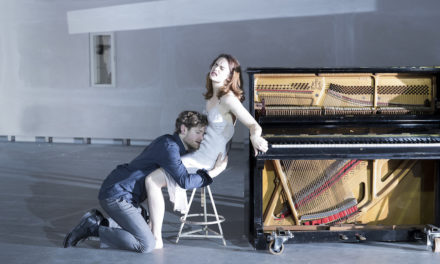In 2017, the cosmetics company Nivea released an advert that was promptly pulled: a white woman’s back, draped in a diaphanous, blanched robe, could be seen juxtaposed against the caption “White is Purity”.[i] Her brown hair is framed by the daylight coming from a window which she faces, illuminated at the outer edges, halo-like. Outcry came social network users pointing out the advert’s racist undertones. Nivea’s white woman appears to glow with luminosity, the eponymous purity indexed by this angelic sheen. In Western society, with its legacy of Christianity, such “white virgins” have reinforced stereotypes about women who don’t fit the racial phenotype as Black feminism has demonstrated.[ii]
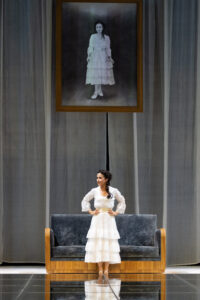
Comme tu me veux by de Luigi Pirandello directed by Stephane Braunschweig at l’Odeon, on august 31, 2021. Starring Chloé Réjon as the Inconnue. (c) Juliette Parisot.
The latest creation to be staged at Paris’s Odéon-Théâtre de l’Europe appears to present spectators with a similar image to the canceled “White is Purity” advert. A monochrome painting shows a woman whose skin is as pale as the dress she wears, the latter’s whiteness emphasized by layers of baroque frills. She glows too, this time from the bottom, with a luminous circle surrounding her at shoe-level. The image is of Lucia, the character of Luigi Pirandello’s Comme tu me veux (As You Desire Me) (1929) who never actually appears in the flesh—having mysteriously disappeared at the end of the Great War after having been raped and violated her by enemy soldiers (Hungarian, Austrian, and German) on the defeated Italian front in 1917. This production, directed by the Odéon’s artistic director Stéphane Braunschweig, may appear to approximate the feel of the “White is Purity” image. Yet, as with all Pirandello’s plays, appearances can be deceiving.
Redemption through White Light
On one level, Comme tu me veux is a tale about one woman’s search for redemption. We first meet the elusively named “Inconnue” (which can be translated as the “Stranger”) in a Berlin cabaret in 1927. Played by Chloé Réjon, the Inconnue is tired of her louche lifestyle: she drinks all night and sleeps all day; she is a dancer, possibly a prostitute, a lover to women and one particularly unstable man, writer Carl Salter (Claude Duparfait). Fortune seems to fall on her when Boffi (Sharif Andoura) enters the scene, convinced that she is Lucia—the woman who we see in the subsequent acts in the painted picture of purity mentioned above. Boffi implores the Inconnue to “return” to Northern Italy with him to rejoin Bruno, Lucia’s lovelorn husband (Pierric Plathier). The Inconnue sees her chance for a new life, and leaps at it.
This production owes its watchability to its fluid visual language. On her journey from dubious debauchery to marital “reunion”, the Inconnue physically throws herself on the cabaret stage, which opens up, coffin-like as she sheds the coil of her former life. The scenography (by Alexandre de Dardel) is coupled with the equally suggestive use of lighting (by Marion Hewlett) which illuminates her from below. Just like the painted portrait of Lucia that we see in the following act, the Inconnue seems to glow like an angel as she enters her new life.

Stunning scenography. The cabaret stage opens like a coffin. The Inconnue (Réjon) is aglow (lighting by Marion Hewlett). (c) Simon Gosselin.

Sandro Botticelli, “The Virgin and Child (The Madonna of the Book),” 1480. The practice of making white women glow stemmed from Italian Renaissance art.
There is nothing new in the visual language of a white woman glowing. Richard Dyer’s White (1997) presents a plethora of images, in Hollywood cinema and the paparazzi press, that systematically align white women with incandescent innocence.[iii] Italian Renaissance artists (Botticelli and the like) started the trend by painting an aura around their white Madonnas. Theatre and film continued the tradition. Sarah Bernhardt was the essence of glowing pallor in her white dress in Alexandre Dumas Fils’ La Dame aux camélias. Her sins as a courtesan were all but forgiven by the consumption that blanched her and suggested her imminent ascension to Heaven.
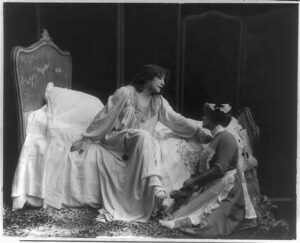
Sarah Bernhardt as the redeemed courtesan Camille. 1913. Rochlitz-Wheeler.
When the Inconnue enters the scene dressed exactly as painted Lucia that dominates the drawing room of Lucia’s aunt Lena (Annie Mercier) and uncle Salesio (Alain Libolt), she recalls the redemptive heroine Camille (Bernhardt) before her. The two are even dressed in strikingly similar white, purifying, robes. And yet the Inconnue soon discovers that something is awry in the Northern Italian household, and this will lead her to distinguish herself from the painted portrait watching over the scene.
Spotlighting Fantasy
The Inconnue learns that her ability to convince aunt, uncle, husband Bruno, friend Boffi, and sister Inès (Lamya Regragui Muzio) that she is the missing Lucia is not simply the fruit of good acting: for reasons of inheritance and financial interest, the family—especially Bruno—has every reason to wish for Lucia’s return. Bruno is willing to dream her return up out from what he knows is to be the Inconnue’s theatre and illusion (something which the Inconnue makes no pretense about). Realizing the family’s financial ploys, and disgusted by them, the Inconnue beguiles Bruno claiming that she wants to be Lucia as he saw her—uttering the line “as you desire me” (comme tu me veux) of the play’s title. Simultaneously, she refutes all connection with Lucia as she existed in reality, independently from her husband’s idealized perception. At this moment, she points at the painted portrait claiming that she is the real “Cia” while the portrait is a fake. The lights dim and show the Inconnue in a chiaroscuro hue. Her difference from the painting is visually reinforced through this change in lighting, no longer like the innocent heroine idealized on the canvas.
And yet, this moment of contrast makes us take a closer look at the painting. Just like the moment when the dimmed lights transform the Inconnue from angel (back) to vamp, we realize that Lucia’s luminosity is nothing more than a trick of the light. The luminous pool surrounding her feet is the result of the ceiling illumination. A patch of darkness separates her head and the overhead light to prove it.
As Peter Baxter points out, from its first arrival on the stage in the 1880s, electric lighting has served to create a luminous aura around protagonists to reinforce the idea of their exceptional status in the drama. Electric lighting was meant to be self-effacing and inconspicuous, coming, seemingly, from “no apparent [external] source”.[iv] In the painted portrait of Comme tu me veux, Lucia’s aura is, pointedly, a product of external lighting. This visual language communicates that her luminosity (and her putative purity) is just as fantasized as that of Inconnue.
As an extract from professor of Italian history Patrizia Dogliani reveals in the production’s press pack, Italian Fascists spread propaganda about the innocent Italian women civilians raped by Hungarian, German, and Austrian soldiers following Italian defeat at the Battle of Caporetto in 1917. They were not motivated by a concern for women’s safety or sympathy for what they had endured. Rather, insisting on the victimhood of these unassuming women allowed Mussolini’s supporters to vilify enemy forces, casting them as deranged and perverted.[v] The Inconnue takes Bruno to task for similar insistence on Lucia as the angel in the portrait that hangs over the family drawing room. The line “As you desire me” is also an attack on the husband’s willed ignorance about the horrors that will have marked Lucia’s body and spirit after the ravages of war crimes.
A character known simply as “la folle” (the madwoman) (played by Cécile Coustillac) then enters the scene. She is the real Lucia according to the Inconnue’s spurned and suicidal lover, Carl Salter. All illusion of Lucia’s untouched perfection comes crashing down at this point. The white back curtain, resembling the frills of Lucia’s petticoat in the painted portrait, drops to the floor with a thud. If this madwoman is the “real” Lucia (and we never have confirmation that she is), she looks and acts even less like the pure painted heroine than the Inconnue. Through chiaroscuro lighting and dark makeup (by Karine Guillem Michalski), her eyes appear hollow, withered by trauma, wholly unlike the brilliant white sheen of the painted portrait above her. The madwoman’s body twitches nervously as she cries out for her aunt “Lena”. Visual resemblance to the portrait is impossible but there are vocal affinities that clearly shake and destabilize the aunt. The play’s final image is of Lena holding the madwoman’s hands in seeming recognition.
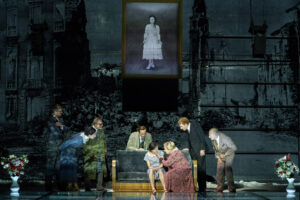
Alexandre Pallu, Lamya Regragui Muzio, Claude Duparfait, Thierry Paret, Cécile Coustillac, Annie Mercier, Sharif Andoura, Alain Libolt. Comme tu me veux (c) Juliette Parisot。
Pirandello was an innovator of theatre-within-theatre. The Inconnue plays at being Lucia, the madwoman too, and we never find out the “real” identity of this missing, enigmatic heroine. Pirandello has been a regular feature of the French stage since the 1920s and since 1983, the Odéon has staged his work a total of seven times.[vi] This is also the fourth time that Braunschweig has taken on the Italian playwright.[vii] If French theatre-makers keep returning to Pirandello—hardly an impure figure himself having been a card-carrying follower of Mussolini for a period—it is because something in his work endures the test of time. Braunschweig’s production holds up the idea—to quote that ill-fated 2017 Nivea slogan—of “White is purity” to a proverbial light and allows us to scrutinize its hold on society, be it the 1920s or the 2010s.
[i] “Nivea removes ‘white is purity’ deodorant advert branded ‘racist’”, 4 April 2017.
https://www.bbc.com/news/world-europe-39489967 [accessed 13 September 2021].
[ii] For instance, Patricia Hill Collins, Black Feminist Thought: Knowledge, Consiousness, and the Politics of Empowerment (New York: Routledge, 2000 [1990]).
[iii] Richard Dyer, White (London: Routledge, 1997), 74, 81.
[iv] Peter Baxter, “On the History and Ideology of Film Lighting.” Screen 16 (1975): 89.
[v] Press Pack, “Comme tu me veux 10 September-9 October”, 2021, 12.
[vi] “Archives”. https://www.theatre-odeon.eu/fr/recherche?term=pirandello [accessed 13 september 2021].
[vii] Press Pack, 17.
This post was written by the author in their personal capacity.The opinions expressed in this article are the author’s own and do not reflect the view of The Theatre Times, their staff or collaborators.
This post was written by Lara Cox.
The views expressed here belong to the author and do not necessarily reflect our views and opinions.

